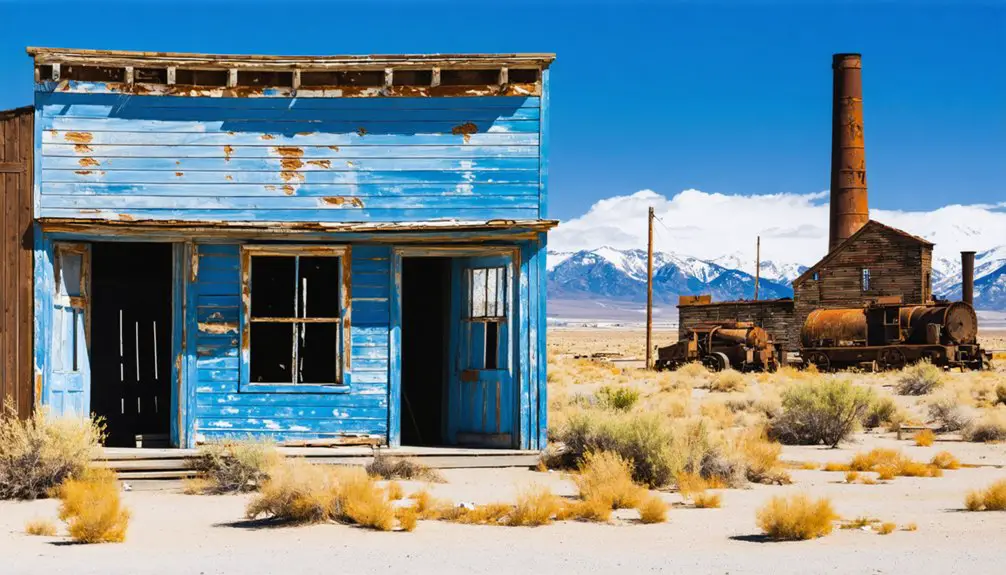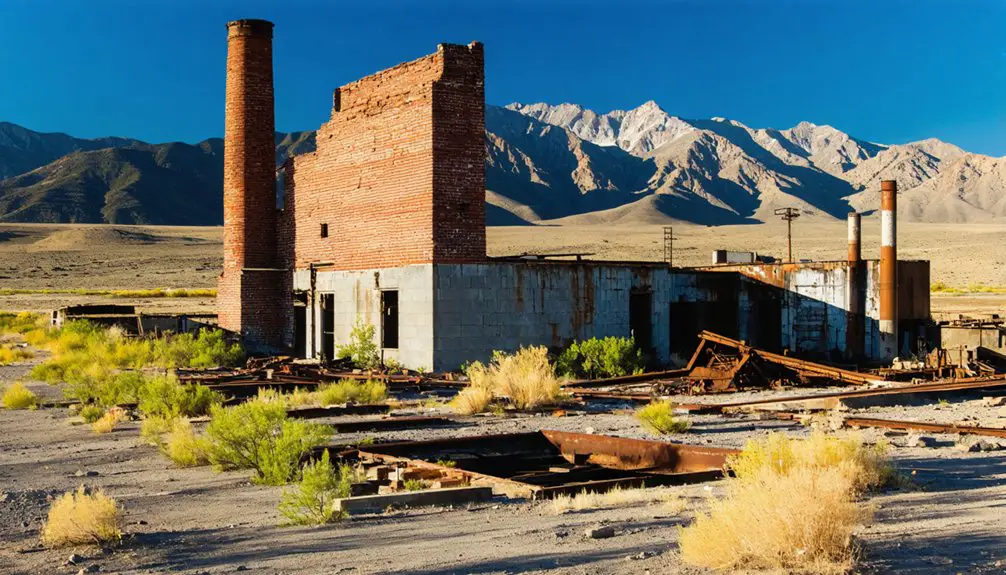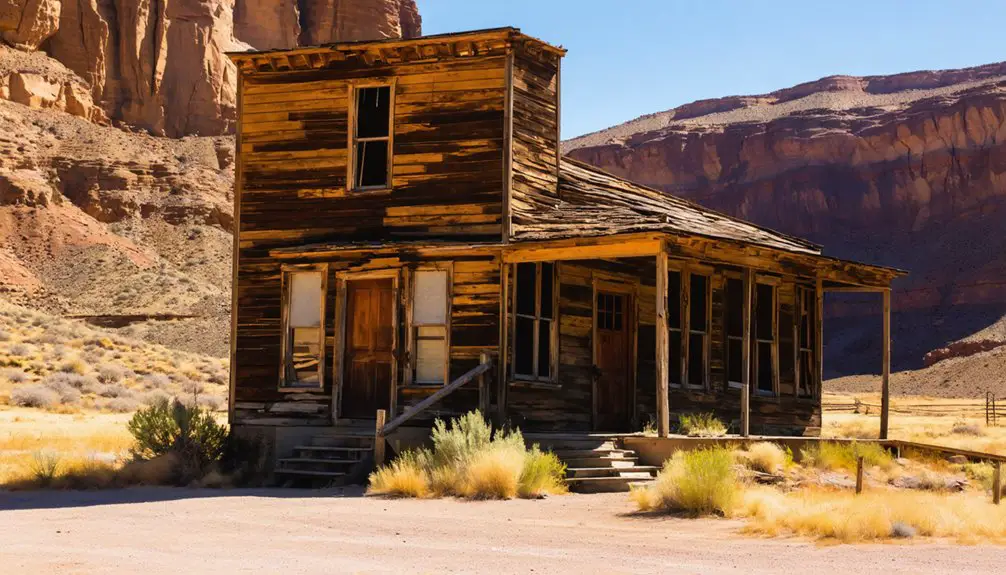You’ll find Garfield at the base of Utah’s Oquirrh Mountains, where Native Americans first inhabited the area thousands of years ago. The Utah Copper Company established this mining town in 1905, building the world’s largest copper smelter and creating a thriving community of 2,000 residents. By the mid-20th century, the town emptied as operations ceased. Today, only the old post office stands, though nearly 200 original homes were relocated to nearby towns. The site’s rich history holds countless untold stories.
Key Takeaways
- Garfield was established in 1905 by Utah Copper Company as a mining town, centered around the world’s largest copper smelter.
- At its peak in the 1940s, Garfield housed 2,000 residents who lived in company-owned homes near the mills and smelter.
- Only the old post office building remains today, with 193 homes relocated to nearby towns like Magna and Hunter.
- The original townsite is now fragmented by Interstate 80 and 201, with Dead Man’s Cave visible from the freeway.
- Nature has reclaimed most of the former mining town, with original roads and home foundations now hidden beneath overgrowth.
Early Native American Presence
While indigenous peoples traversed the Salt Lake Valley for millennia, the area around Garfield, Utah served as a particularly significant corridor for seasonal habitation and migration.
You’ll find evidence of this Native American migration in Dead Man’s Cave, where skeletal remains date back to 3,000-7,000 B.C., proving the area’s importance as a temporary dwelling.
The region’s rich indigenous habitation history includes the Sevier, Fremont, and Anasazi cultures, who left their mark through complex village structures and trade networks.
The Fremont people, active from 700-1300 AD, developed a unique blend of hunting, gathering, and farming.
Archaeological excavations at Coombs Village revealed it was a major trade center for Ancestral Puebloans from AD 1075 to 1235.
Later, the Southern Paiute and Ute tribes made their home here, utilizing the natural resources of the Oquirrh Mountains for sustenance and commerce.
Early explorers like Captain John Fremont camped in the area during his 1843 expedition, documenting encounters with indigenous communities.
The Birth of a Mining Town
As Utah’s copper mining industry boomed in the early 1900s, the Utah Copper Company established Garfield in 1905 along the old 21st South road, just a few miles west of Magna. The town’s birth marked a significant turning point in the region’s cultural impacts, as the company quickly transformed the area into a bustling industrial hub. Trading Post and hotels were constructed by 1907 to accommodate the growing workforce.
Construction of what would become the world’s largest copper smelter began in August 1905, just before open-cut mining techniques revolutionized operations at nearby Bingham Canyon.
The American Smelting and Refining Company built this massive facility with backing from the Gutenheimer Company. You’ll find it fascinating that this investment signaled unprecedented confidence in the region’s mining potential, ushering in a new era of American industrial might and technological advancement. The smelter was designed to process 500 tons of concentrate daily, demonstrating the ambitious scale of the operation.
Utah Copper Company’s Legacy
You’ll find Utah Copper Company’s early influence taking shape in 1905 when construction of the massive Garfield smelter began under ASARCO’s direction, marking a new era of industrial development.
By 1906, the company had established both the Magna Mill for ore processing and an electric generating plant to power its expanding operations.
The Guggenheim family’s financial backing and strategic control of both Utah Copper and ASARCO enabled this rapid industrial growth, transforming Garfield into a thriving company town that would house over 2,000 residents at its peak. The town’s development came after surface mining initiated in 1903 under the leadership of Daniel Jackling and Robert Gemmell. The smelter officially commenced operations in August 1906, marking the beginning of decades of copper production at the site.
Mining Operations Begin
When Utah Copper Company began operations in 1903 under the leadership of Daniel C. Jackling and Enos A. Wall, they revolutionized mining techniques by introducing open-pit mining to extract low-grade porphyry copper ore at Bingham Canyon.
The low-grade ores yielded profitable amounts of copper at just 2% concentration through innovative extraction methods.
You’ll find that early partnerships with the Guggenheims provided essential investment for expansion and mill construction.
The company’s ore processing capabilities grew quickly with the completion of the Copperton mill in 1904. They partnered with ASARCO to build the Garfield Smelter, signing a 20-year contract to supply copper concentrates.
Steam shovels and railroads transported massive amounts of ore, while an electric generating plant powered the growing operation. The company later merged with Boston Consolidated Mining in 1906, strengthening its position in the industry.
Town’s Industrial Rise
Following Utah Copper Company’s 1905 purchase of Garfield, the town rapidly evolved into a thriving industrial community centered around the new smelter and refinery operations.
The industrial growth transformed this area into a bustling hub, with strategic investments from the Guggenheim family fueling massive expansion. The ASRCO smelter established a strong foothold west of Garfield, marking a pioneering development in the region’s mining industry.
You’d find well-maintained company housing accommodating over 2,000 residents at its peak, creating a self-sufficient community that supported the ambitious mining operations. The Kennecott welfare department established extensive recreational programs and facilities to support worker wellbeing.
- A complete town infrastructure featuring hotels, stores, schools, and a post office
- Modern facilities including a steam electric plant and the Magna Mill for ore processing
- Company-owned rental units maintained by Utah Copper for worker housing
- Strategic location near the smelter, with convenient access to Magna and Bingham Canyon mining operations
Daily Life in Garfield
During Garfield’s peak in the 1940s, nearly 2,000 residents lived in this company-controlled mining town, where daily life revolved around the mills and smelter operations.
You’d find most men working shifts at either the mills or smelter, while their families settled into wooden company homes that lined the practical street layout. Mining routines shaped everyone’s schedules, with industrial noise and dust becoming part of daily existence.
Despite the demanding work environment, you’d experience a tight-knit community where neighbors forged strong bonds. Community gatherings and informal social events offered relief from the industrial grind.
You could join others at local parks and recreational spaces, though options were limited. The surrounding Salt Lake Valley weather influenced both work and leisure, while ever-present tailings ponds and occasional pollution reminded you of the town’s industrial purpose.
The Town’s Final Years

The steady hum of industrial life in Garfield came to an abrupt halt in 1955 when Kennecott Copper announced its decision to exit the landlord business. The shutdown impact rippled through the community as residents faced tough choices: buy and move their homes or watch them face demolition.
Yet community resilience shone through as many families chose to physically relocate their structures to new sites.
- Families gradually dispersed between 1955-1957, marking the town’s shift to ghost town status
- Resourceful residents dismantled and transported entire homes to new locations
- Strong emotional bonds persisted despite physical separation of neighbors
- Former residents later organized commemorative events, including a centennial celebration at Holmes Park
Archaeological Discoveries
Archaeological excavations near Garfield have revealed a rich tapestry of human habitation stretching back thousands of years.
You’ll find prehistoric artifacts dating between 3,000 and 7,000 B.C. in Dead Man’s Cave, including ancient skeletal remains and tools that tell the story of early Native American life.
The cultural significance of the area becomes clear through discoveries at Coombs Village, a major trade center from AD 1075-1235.
Here, archaeologists uncovered evidence of the Sevier, Fremont, and Anasazi cultures, showing complex social networks and trade routes.
Ancient peoples of the Southwest – the Sevier, Fremont, and Anasazi – built intricate trading networks across harsh desert landscapes.
University of Utah researchers, during the Upper Colorado River Basin Salvage Project of 1957-1958, preserved essential artifacts that would’ve been lost to modern construction.
Today, you can explore these fascinating finds at local visitor centers and Anasazi State Park.
Modern-Day Remnants and Remembrance

If you visit Garfield’s former site today, you’ll find nature has largely reclaimed the once-bustling company town, with only the old post office building still standing and Dead Man’s Cave fenced off from public access.
You can spot traces of original roads winding through trees and grass, while former residential areas have become overgrown, hiding the foundations of homes that once housed hundreds of families.
The physical legacy of Garfield lives on through the approximately 193 homes that were relocated to surrounding towns like Magna and Hunter, where some residents purchased and salvaged materials from condemned houses for as little as $10 each.
Physical Site Today
Modern-day visitors to Garfield’s original townsite will find few remnants of the once-bustling mining community. The area, now fragmented by Interstate 80 and 201, has largely returned to nature.
While site accessibility remains possible via nearby highways, you won’t find marked trails or interpretive signs. Instead, you’ll discover an environment where trees, grass, and weeds have reclaimed the land where homes once stood.
- Dead Man’s Cave stands as the most visible landmark, viewable from the freeway near a tailings pond
- Most residential structures have been removed or relocated, leaving minimal evidence
- No official monuments mark the townsite, though community gatherings occur at nearby Holmes Park
- Mining debris and occasional foundation remains exist, but they’re not preserved as tourist attractions
Preserving Garfield’s Legacy
Though physical traces of Garfield have largely vanished, the town’s legacy lives on through dedicated preservation efforts.
You’ll find former residents maintaining strong emotional connections through community storytelling, with Romrell’s upcoming book documenting these cherished memories. Historical societies are actively collecting oral histories, photographs, and documents to safeguard Garfield’s intangible heritage for future generations.
Digital platforms now enable dispersed descendants to share memories online, while local museums integrate the town’s history into regional exhibitions.
You can attend centennial celebrations that reunite former residents and their families, featuring educational talks about Utah’s mining era.
Through these preservation initiatives, including archival projects and interpretive markers, you’re witnessing how a disappeared town’s spirit endures beyond its physical remains.
Frequently Asked Questions
What Was the Average Home Price in Garfield During Its Peak Years?
While exact records don’t exist, you’d find homes valued between $1,000-$3,000 during peak years, as economic factors like Kennecott Copper’s control and company-town policies kept home values artificially low.
Were There Any Notable Crimes or Criminal Incidents in Garfield’s History?
You won’t find significant documented crimes or unsolved mysteries in the records. Despite local legends that might suggest otherwise, historical sources don’t reveal any notable criminal incidents worth mentioning.
What Happened to the Town’s Cemetery After Garfield Became Abandoned?
Walking past weathered headstones, you’d find the cemetery largely intact but neglected. Local historical societies eventually took over cemetery maintenance, though many burial records were lost during the town’s abandonment.
Did Any Famous Movies or Television Shows Feature Garfield as a Location?
You won’t find any documented film locations or ghost stories from Garfield in mainstream media. While Utah’s ghost towns have hosted many productions, there’s no evidence of movies or shows filming here.
How Many Children Typically Attended Garfield’s School Before the Town Closed?
Picture a modest classroom where enthusiastic young faces gathered – you’d typically find between 10-30 students attending the school, with numbers fluctuating based on mining community dynamics before dwindling in the mid-1950s closure.
References
- https://onlineutah.us/garfieldhistory.shtml
- https://www.deseret.com/2005/8/12/19906627/memories-of-a-company-town/
- https://www.uen.org/utah_history_encyclopedia/g/GARFIELD_COUNTY.shtml
- https://nhmu.utah.edu/explorer-corps/marker/garfield
- https://exhibits.lib.utah.edu/s/ghost-towns/item/139491
- https://www.utahsadventurefamily.com/grafton-ghost-town/
- https://www.youtube.com/watch?v=cdr-7uCjkX8
- https://www.familysearch.org/library/books/dcms/delivery/DeliveryManagerServlet?dps_pid=IE215324
- https://archiveswest.orbiscascade.org/ark:80444/xv19515
- https://utahrails.net/mining/smelters-garfield.php



